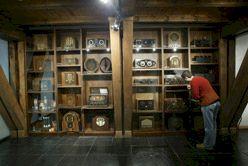
 |
Museo de la Radio - Luis de Olmo |
24400 Ponferrada, Spain (León) |
|
| Address |
Calle de Gil y Carrasco, 7
"Coats of Arms" House |
| Floor area | unfortunately not known yet |
Museum typ
Exhibition
Radio and Kommunication in general
- Media
- Radios (Broadcast receivers)
- Transmitting and Studio technique
- Gramophone (no electrical sound transmission)
|
Opening times
|
Wednesday - Saturday: 11:00 to 14:00 h. & 16:00 to 19:00 h. - in Summer til 20:00 h Sunday: 11:00 to 14:00 h. Miércoles - sábado: 11:00 a 14:00 h. & de 16:00 a 19:00 h. - En verano hasta las 20:00 h
domingo: 11:00 a 14:00 h. |
||||||||
|
Status from 09/2014
|
Adults € 2,70; Reduced € 1. Adultos: 2,70 €; Jóvenes hasta 18 años: 1 € |
||||||||
| Contact |
|
||||||||
| Homepage |
www.museoradioponferrada.com www.ponferrada.org/turismo/en/museums/luis-del-olmo-radio-museum |
||||||||
Our page for Museo de la Radio - Luis de Olmo in Ponferrada, Spain, is not yet administrated by a Radiomuseum.org member. Please write to us about your experience with this museum, for corrections of our data or sending photos by using the Contact Form to the Museum Finder.
| Location / Directions |
Ponferrada is easily accessible by highway (Autovía A-6) and intercity public transportation is readily available, as several daily ALSA bus services and RENFE passenger trains link the city with major population centers in Spain and the rest of Europe. The museum is located inside the building known as "Casa de los Escudos", an ancestral late baroque style house that displays rococo influences. |
Some example model pages for sets you can see there:
CS: Tesla; Praha, Talisman 308U (1953-58)
NL: Philips; Eindhoven 2801 (1928)
NL: Philips; Eindhoven 2511 (1928-31)
NL: Philips; Eindhoven 2515 (1930/31)
USA: Atwater Kent Mfg. Co 4340 Model 10 Radiodyne (?) (1923)
USA: RCA RCA Victor Co. Radiola Superheterodyne AR-812 "Semi-Portable" (1924)
USA: Tower Mfg.Co., Meistersinger (1925)
USA: RCA RCA Victor Co. Radiola 20 (1925)
USA: RCA RCA Victor Co. Radiola 26 (reflex) (1925/26)
USA: Grebe, A.H. & Co.; Synchrophase MU1 with chain (1926)
USA: Crosley Radio Corp.; 141 "Book Case" (Library Universal) Ch= 141 (1932/33)
USA: Hallicrafters, The; SX-122A (1967-70)
| Description | The museum includes an exhibition of one of the most important collections of radio receivers in Spain that belongs to Luis del Olmo. This huge collection which includes 200 receivers will show the visitor the technical and aesthetic evolution of these equipments, from the very first receivers of galena to the small transistors of the seventies or the latest high-tech digital radios.
If you want to see more examples, you must visit the room devoted to receivers designed by the best European and North American manufacturers such as Telefunken, Philips, Crosley, Atwater Kent, Marconi, Radiola, etc It offers the possibility to learn about the history of the radio in Spain through plenty of radio programmes that have been compiled thanks to the collaboration of RNE, SER; COPE y ONDA CERO (national radio channels). On the first floor, we find the museum itself. In the first room, the origins of the radio are explained, and following this, in the larger hall of the building, there is an explanation of the history in Spain with the support of graphic material, texts, sounds and radio apparatus. The story is structured in panels and cabinets according to decade, and in each one of them there is offered a selection of sounds which identify the style of the radio at each moment and reminds us of the voices of the principal protagonists, both commentators as well as personages of the history. The system employed, acoustic bells, allow for individual listening, and avoids the use of headphones, which gives greater liberty at the moment of enjoying the sound reception. Situated on the ground floor are the reception area, the shop, the radio teaching hall, the storeroom, the library and the restoration workshop. The radio teaching hall is a space devoted to the exhibition of a good number of receivers and other pieces such as broadcasting valves, microphones, etc., in order to complete the explanation of the technical support which sustained the radio. All this with a selection which faithfully reflects different criteria of manufacturers and models, or even of economic value, since there are apparatus with very high value owing to their rareness. For all these reasons, this hall is the ideal complement for those who are keen, above all, on the apparatus of the Twenties and Fifties, which is the period on which the great radio collectors focus their attention. In the hall, there is the production of a light and sound effect which consists of leaving switched on, only the lights of the dials while the voice of L del O is heard in a personalised goodbye to our visitors. The result obtained is that the radio adventure becomes reality once more by means of that little light which indicated an open road to information and entertainment. |
Radiomuseum.org presents here one of the many museum pages. We try to bring data for your direct information about all that is relevant. In the list (link above right) you find the complete listing of museums related to "Radio & Co." we have information of. Please help us to be complete and up to date by using the contact form above.
[dsp_museum_detail.cfm]
| Data Compliance | More Information |
 museoradioponferrada.com
museoradioponferrada.com 